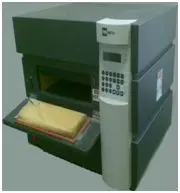 Building physics laboratory
Building physics laboratory
- Thermal conductivity measurements
For measuring the thermal conductivity of insulating samples a Lambda 2000 Heat flow meter (HFM) is used. This equipment is designed to determine the thermal conductivity of insulation materials with 30 cm x 30 cm area and with 2 to 10 cm height geometry.
- Measurement of the sorption isotherms
Before treating the samples in the CLC climatic chamber, samples are dried to changeless weight at 343 K under normal atmospheric pressure at all times. This temperature was chosen because it is fairly under the melting point of the polystyrene (about 373 K) and during the dehydrating process at this temperature, the material does not suffer losses in its physical and chemical properties. To determine the sorption curves (moisture content of material in function of relative humidity (RH %) of air at 293 K) the samples were kept in the CLC chamber at under varied relative humidity.
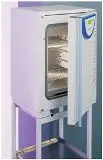
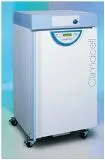
- Thermal resistivity measurement of a wall covered with 2 mm thick thermal insulating plaster by with Hukselfux apparatus
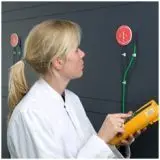
Hukseflux HFP01 heat flux sensors serve the reason to measure the heat flux that flows through the object in which it is incorporated or on which it is mounted. This instrument can measure the Heat Flux, and air temperature, so the R-value of building envelopes can be calculated according to ISO 9869, ASTM C1046 and ASTM C1155 standards. These apparatus can be used from 250 K-350 K temperature range and it can measure from 2000 to -2000 W/m2 range with about 5% accuracy. These measurements are carried out in our laboratory (see Figure1), but from both sides everything is removed, only empty rooms were heated and cooled. The measurements were carried out by using two HF sensors with 5.024x10-2 m2 rounded surface for good spatial averaging fixed up at different points on the wall.
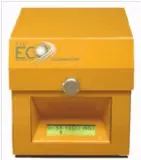
- Measurement of the calorific value of the building materials with CAL2ECO calorimeter
Bomb calorimetry is a procedure which determines the heat of combustion or calorific value of solid and liquid materials which are burned. It is a primary test of great importance to the following industries : coal production; power stations; fuel analysis; animal feed research; educational institutes; commercial analytical laboratories; by-product analysis; building materials; etc. Theory of "dry isothermal" CV determinations is the following. The CV (Calorific Value) of a substance is measured by burning it in a controlled environment. The resulting heat released by this combustion i.e. the net temperature rise is proportional to the calorific value.
Thermal engineering research group
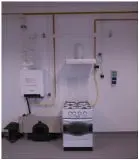 Gas technology laboratory
Gas technology laboratory
In the lab every gas appliances can be found which is common nowadays Here we can exanime the constructional features of the gas appliances. Measurements can be made to control the operating parameters of the devices. (gas consumption, flue gaseous composition, state of the air, efficiency, etc.).
BKM-IQE laboratory
Test room placed in an adiabatic chamber. In the test room the operation of floor heating, wall heating, ceiling heating and radiator heating systems are tested from thermal comfort point of view. In the room wall and ceiling cooling system is installed. The heating and cooling systems can be combined with different ventilation systems; consequently the effect of different comfort parameters can be tested simultaneously. Themocamera, temperature and relative humidity data loggers, air velocity-, turbulence intensity, wet bulb globe temperature measuring instruments are available.
Water laboratory
In this laboratory the following experiments can be followed. Examinations of the wing-wheeled water meters. The aim of the examinations are to determine the interrelation between functions and measurement values, and representation by graphical methods, furthermore to determine the initial sensitivity of different sized and aged water gauges; Examination of the function parameters of pressure raiser equipment; Investigation of the flow dynamics of rotational meters, calibration as well as examination of the domestic hot water container.

Air technology laboratory
Nowadays the closed spaces are artificially supplied by fresh air. So that researchers at the University Of Debrecen Faculty Of Engineering put in a great amount of emphasis to transmit knowledge, which describes the improvement of the person’s comfort feeling in the building with well controlled air technology systems.
Devices: Portable multifunctional measuring instrument, Air mass measuring instrument, Data collectors: temperature, and humidity sensors, CO2measuring instrument, Portable tachometer withoptical and contact sensor adapter, Infra thermometer with gauge field, Pressure gauge instruments with inner sensor.
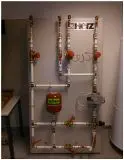
Heating technology laboratory
There are possibilities for measuring the features of the pumps under operation. Examinations of the regulation of heating circles as well as of the features of a solar collector system under operations are available also.
Heating mechanic laboratory
This lab is making place for the following practice courses: Laboratory Practices, Diagnostic of Building Engineering Systems, Heat and Fluid Technology Machines.
Devices: Pump-characteristic curve measuring instrument; measurement bench for investigating the structural, and dynamical hydraulically regularizations. Measurement bench for heat pump.
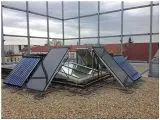
Sustainable Building Energy Information Center of University of Debrecen (Dem)
It can be found at the Campus of University (26. Kassai, Debrecen). The low heat loss of the building is achieved by thick thermal insulation panels and external wall cavity, openings with three layered glazing, ventilation system with built-in heat recovery unit. The heat flow demand of heating and domestic hot water can be covered by three active heat source, such as solar collectors, air/water heat pump or distant heating.
The solar collectors can produce heat for the distant heating of the city. The heat pum at cooling mode serves the cooling system of the building as a chiller. The building is suitable of using significant direct solar gain and the summer heat load can be lowered by passive elements. In the building three similar labors can be found with different orientation. In all the tree rooms operation of the passive and active system can be regulated and studied. There is possibility to do building energy and comfort tests. The building service systems can be observed during operation in the demonstration rooms. The central building automation controls, regulates the operation of the systems, and collects the date concerning the state of the system.
The building can be visited by anybody, it has three functions, such as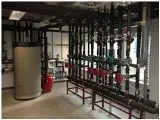
- to get know and popularize the sustainable building energy solutions for the population
- to support education of the students, they can get to know and study structure of the systems,
- make measurements, there is a possibility to do experiments.